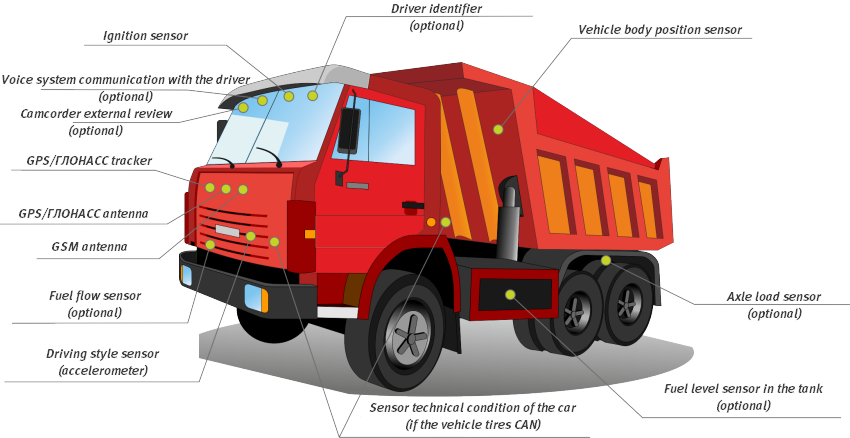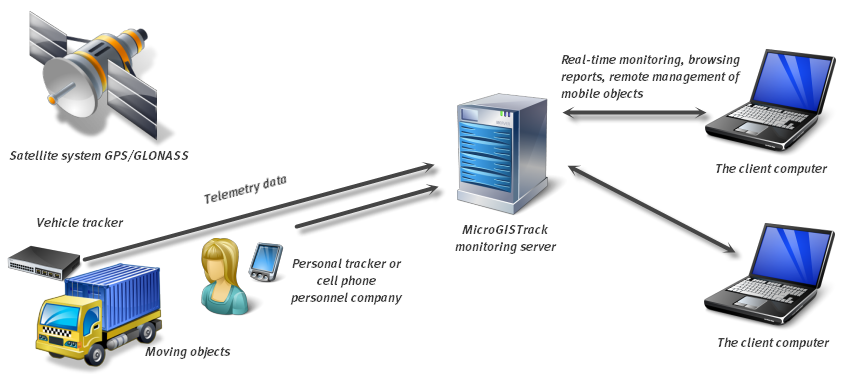MIcroGISTrack Freight Monitoring
The GPS/GLONASS system for monitoring cargo transportation is a simple and effective tool for reducing the current costs of maintaining and maintaining a fleet of vehicles and improving the safety of drivers, passengers and cargo.
GPS/GLONASS monitoring system for cargo transportation - provides effective control and management of the transport complex of the city or the company's fleet through logistics automation technologies, satellite tracking, GPS monitoring and much more.
The use of GPS / GLONASS systems for monitoring and managing vehicles is a qualitatively new level of vehicle fleet management.
Features of the GPS/GLONASS system for monitoring cargo transportation:
- The use of this system is possible on any modern cars, without causing harm to regular electronic systems.
- The system is completely autonomous and does not require intervention in the operation of regular vehicle systems.
The GPS/GLONASS system for monitoring cargo transportation provides:
- Control the location and condition of your cars without leaving your home or office;
- Monitoring compliance with the operating modes of vehicles;
- Safety of your cars;
- Prevention of misuse of service vehicles;
- Improving the efficiency of the use of vehicles and special equipment;
- Improve the efficiency of route planning and cargo transportation safety;
- Prevention of fuel theft;
- Reducing costs and prices for vehicle repairs;
- Identification of dishonest employees;
- Statistics and analysis of the fleet activity;
What does the customer need to have?
- Any personal computer or mobile device with Internet access;
- Satellite terminal (tracker) installed on the car;
What are the advantages of the GPS/GLONASS system for monitoring cargo transportation?
- The customer can control moving objects in real time.
- The system does not require the preparation of a special workplace for control.
- The system does not require the installation of special software for monitoring.
- Access to the database of objects is carried out from any computer or mobile device that has Internet access through a regular WEB browser.
- No special knowledge or training is required to use the system.
- The system keeps a history of movements over a long period of time.
- The system works with a large number of open map services.
How does it work?
- The satellite terminal is discreetly installed inside the vehicle and connected to systems whose parameters need to be controlled by the customer;
- Control over the movement of the object, as well as over the controlled parameters, is carried out using the Internet in real time;
- In the event of an emergency situation, the driver will be able to send you or the operator an alarm signal with one click on the “panic” button;
- A huge number of reports available in the system will greatly simplify the analysis of the performance of both a single vehicle and the fleet as a whole;
- Satellite terminals installed on the vehicle, at the request of the customer, can be additionally equipped with cameras, hands-free kits, immobilizers, information boards, fuel consumption sensors ...

Scheme of operation of the GPS/GLONASS system for monitoring cargo transportation:

The system implements:
- Remote control over the movement of an object;
- Remote control of modes and parameters of transport operation / spec. techniques / mechanisms;
- Remote check of the status of vehicle systems (including the battery);
- Remote control of gas stations and fuel consumption;
- Remote control of the route sheet of the task;
- Additional types of control: photo control, geo-zone visit control, access control;
- Interaction with any car security system;
- Remote blocking of the engine operation / Control of the operation of mechanisms;
- Transmission of alarm signals from the SOS button (panic button) and car alarm to the dispatcher * and operator * of the system with full duplication to the owner's phone numbers;
Additional features:
- Building geofences with the ability to control entry/exit from/to the zone(s);
- Construction of geocorridors with the ability to control entry/exit from/to the corridor(s);
- Building/planning routes and calculating their distances;
- Building route sheets and tasks;
- Building a large number of reports on the work / use of transport;
- Building a large number of reports on the work of the driver(s);
Types of reports:
- The distance traveled for the period;
- The distance traveled during the work;
- Travel time per period;
- Downtime per period;
- Report on movement in geofences;
- Report on visiting geofences;
- Report on movement in geocorridors;
- Report on visits to geocorridors;
- Fuel consumption reports;
- Report on fuel consumption according to norms (coefficients are available);
- OBD diagnostic report;
- Speeding report;
- Report on exceeding the set speed;
- Report on the last location of monitoring objects;
- HR information report;
- Report on excessive inactivity of monitoring objects;
- Trip history report;
- Reports on the work of drivers;
- Photo reports;
- As well as group and summary reports.
Effect of implementing GPS/GLONASS cargo transportation monitoring system:
- Significant fuel economy;
- High-quality transport logistics and route optimization;
- Control of the speed limit and time on the route;
- Permanent and reliable control of the location of transport and cargo;
- Efficiency in the use of vehicles;
- Reduction of cases of exceeding the established standards (violation of the speed limit, deviation from the given route, etc.);
- Real-time monitoring and control of routes
- Safety of drivers, cargo and vehicles;
- Exclusion of misuse of technology;
- Discipline of drivers and dispatchers;
- Stability in the provision of services;
- Consignee customer satisfaction;
- Reducing fuel costs and related costs;
- Reducing vehicle maintenance costs;
- Reducing the cost of mobile communications;
- Increase the life of vehicles;
- Always access to rich insights and reports
Conclusion:
- The amount of investment in equipment, operating costs and payback period have reached levels acceptable even for private vehicle owners.
- Modern, reliable equipment offered by our company is the safety of your vehicle in the conditions of life in a modern metropolis.
- Therefore, it's time to think about whether to remain in the dark and work according to the old scheme, or switch to new advanced technologies that allow you to be more confident in your own safety?!



